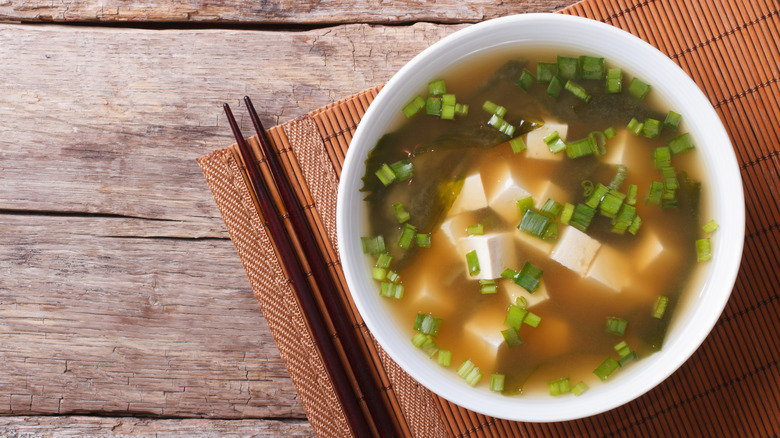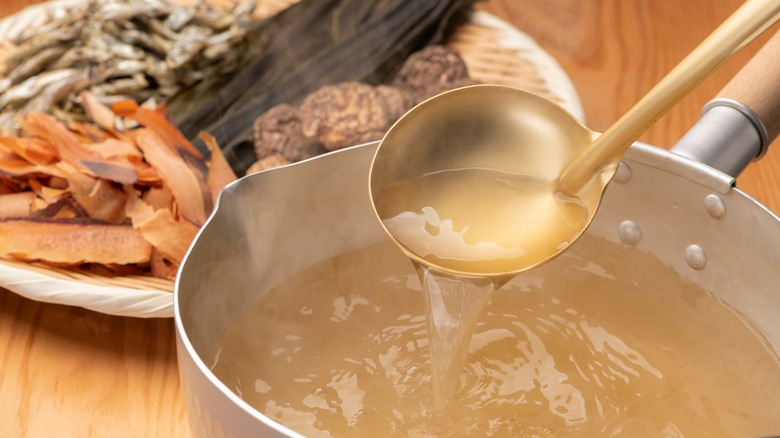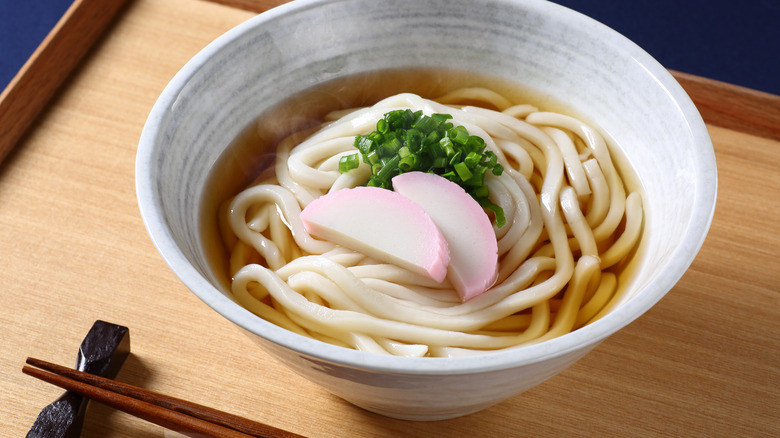Your Miso Soup Is Missing Dashi Broth
Often referred to as one of the foundations of Japanese culture and cuisine, miso soup is eaten by around 90% of households in Japan, and the traditional soup is consumed once a day, if not more, by about 75% of all Japanese people, per Wa-Shoku. Miso soup is made of two basic ingredients: miso paste and dashi, according to Kobe Jones. It's hard to pinpoint the exact creation of the first miso soup, but it may have been invented in China and made its way to South Korea and Japan eventually. During the Kamakura period, which was from 1192 to 1333 (via Britannica), Buddhist monks traveled from China to Japan and introduced the Japanese people to special mortars that helped grind miso, creating miso paste, according to marukome.
Interestingly, samurai warriors would take miso paste into battle as their food rations because it could be easily dissolved in water and make a quick, nutritious bowl of miso soup. Appearing similar in color to creamy peanut butter, miso paste is made of koji fungus, fermented soybeans, and salt (via Wa-Shoku). Miso soup is so popular that there are now freeze-dried miso soups and instant miso soups. Miso paste is what really gives miso soup its unique flavor, but the dashi broth is an important base to ensure all of the cozy, umami flavors. To make the very best bowl of miso soup ever, you should definitely use dashi broth as the base. Here's what you need to know about dashi broth.
Dashi broth is the flavorful base that every great miso soup deserves
Dashi is a traditional Japanese broth that's commonly made with dried bonito, dried shiitake mushrooms, dried sardines, and dried kelp, which is a kind of seaweed, per Kobe Jones. A vegetarian or vegan version of dashi can also be prepared by using scallions, leafy greens, mushrooms, wakame seaweed, and tofu, according to Wa-Shoku. Dashi can be made in about 30 minutes, and there are a few variations that are made with different ingredients. The first dashi, also known as kombu dashi, was made around 800 years ago and was made with two simple ingredients: Japanese spring water and kombu, which is a specific kind of kelp (via Gurunavi). The kombu kelp is what gives dashi its unique umami flavor because it has glutamate.
Shiitake dashi is made by placing shiitake mushrooms in a bowl of lukewarm water and letting them soak until a dark brown broth is created. Shiitake dashi is commonly combined with kombu dashi for a more intense flavor. Awase dashi is the most common dashi made nowadays and is made similarly to kombu dashi, except once the kombu has simmered long enough, it's removed and dried bonito fish flakes are added. The dried bonito fish flakes are then brought to a brief boil and strained, leaving behind awase dashi. There's also iriko dashi, or niboshi dashi, which is made by simmering water and whole dried baby anchovies or dried baby sardines until the broth forms.
Other yummy uses for dashi broth
Dashi broth isn't only used as a base for miso soup and it's an important, central aspect of a lot of Japanese cuisine. A common way of cooking Japanese dishes is by simmering them in dashi broth, and this is called nimono in Japanese, per Gurunavi. A few examples of simmered dishes that use dashi broth are kabocha no nimono, which is simmered Japanese pumpkin; nikujaga, which is a stew with potatoes and meat; buta no kakuni, which is pork belly that's been stewed in dashi; and buri-daikon, which is yellowtail and daikon radish that have been braised in dashi. Another popular Japanese dish is dashimaki tamago, which is a rolled omelet of sorts that combines eggs with dashi broth.
Additionally, a common way to cook vegetables in Japan is by steeping them in dashi, which is known as ohitashi in Japanese. Popular dishes include eggplant ohitashi, spinach ohitashi, and okra ohitashi. Mixing dashi with mirin, sugar, and soy sauce can make a sauce for cold noodles and fried items such as tempura or dumplings. Dashi can also be used to make takikomi-gohan, which is a Japanese rice dish with meat, vegetables, and mushrooms that's been cooked in dashi. Dashi is a nutritious broth that has a lot of health benefits, especially when used to make miso soup. It may help support a healthy gut and help with digestion and proper blood flow, which in turn helps reduce high blood pressure, according to Wa-Shoku.


